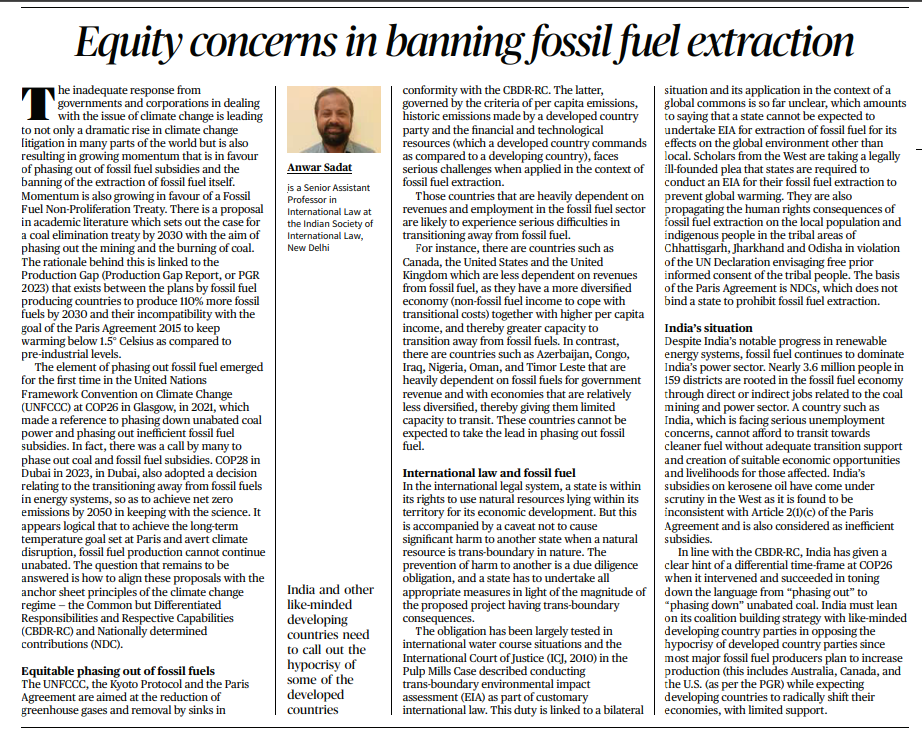Introduction
- The global response to climate change is witnessing a paradigm shift with increasing momentum favoring the phasing out of fossil fuel subsidies and extraction.
- This shift is driven by a surge in climate change litigation and concerns over the inadequacy of government and corporate responses.
International Agreements and Initiatives
- UNFCCC and COP26: The UNFCCC and COP26 have acknowledged the need to transition away from fossil fuels, particularly coal, and phase out inefficient subsidies. COP28 in 2023 further emphasized the urgency of transitioning to achieve net zero emissions by 2050.
- Fossil Fuel Non-Proliferation Treaty: There is growing advocacy for a Fossil Fuel Non-Proliferation Treaty to address the Production Gap and align with the goals of the Paris Agreement.
Challenges and Considerations
- Equitable Phasing Out: The principle of Common but Differentiated Responsibilities and Respective Capabilities (CBDR-RC) poses challenges in transitioning away from fossil fuels, particularly for developing countries heavily reliant on fossil fuel revenues.
- International Legal Framework: While states have the right to exploit natural resources within their territories, there is a caveat to avoid significant harm to other states. However, the applicability of this obligation in the context of global environmental concerns remains unclear.
India’s Perspective
- Current Situation: India, despite progress in renewable energy, heavily relies on fossil fuels, primarily coal. The transition away from fossil fuels poses challenges, considering the significant employment and economic dependencies.
- Policy Stance: India advocates for a phasedown rather than a phaseout of unabated coal, emphasizing the need for differential timelines and support for developing countries. However, India’s subsidies on kerosene oil have faced scrutiny for inconsistency with climate goals.
Conclusion
The discourse surrounding climate change and fossil fuel policies underscores the complexities of transitioning to a sustainable energy future.
While there is growing momentum for phasing out fossil fuels, equitable and pragmatic approaches are essential, considering the diverse socioeconomic contexts of different nations.
Introduction: The Significance of “Viksit Bharat”
- Interim Budget Reference: The term “Viksit Bharat” was mentioned in the interim budget speech, echoing its presence elsewhere.
- Sanskrit Transliteration Challenge: Transcribing Sanskrit words into English poses challenges, particularly regarding the correct interpretation of diacritical marks or the absence thereof.
Two Interpretations: “Shine” or “Move”
- Linguistic Analysis: The ambiguity arises concerning whether “sha” refers to “to shine” or “sa” to “to move or go,” influencing the meaning of “Viksit Bharat.”
- Developmental Connotation: “Viksit Bharat” symbolizes a developed India, aligning with the Prime Minister’s vision for 2047, articulated during the 77th Independence Day speech.
Defining Development: Metrics and Perspectives
- Diverse Criteria: The concept of development necessitates defining metrics, such as per capita GDP, industrialization level, service sector importance, and HDI.
- Divergent Criteria and Perspectives: Different criteria for development may lead to varied identifications, akin to the blind men and the elephant parable.
Evolution of Development Paradigms
Historical Context: Previously, the world categorized economies into developed, developing, and least developed countries, which has become less relevant due to the complexity and diversity of economies.
Contemporary Frameworks: Organizations like UNCTAD and the World Bank have shifted from binary distinctions to nuanced classifications based on income levels.
Prospects for India’s Development by 2047
- Potential Benchmarks: Options to measure India’s progress by 2047 include achieving an HDI above 0.800 or transitioning to the high-income category in constant or current US dollars.
- Challenges and Perspectives: The choice of benchmark reflects differing priorities and feasibility considerations.
Conclusion
Dynamic Nature of Development: The concept of “Viksit Bharat” encapsulates India’s aspiration for development, subject to evolving paradigms and contextual interpretations. Achieving this vision requires not only economic growth but also comprehensive societal progress.



